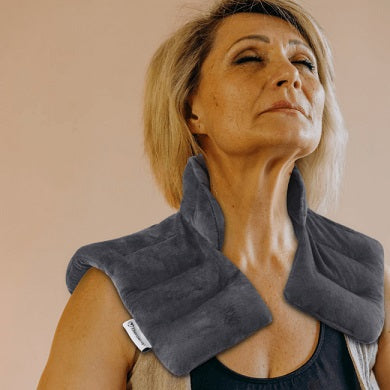Heat vs. cold therapy - which is best for dealing with neck pain? Don’t worry, you wouldn’t be the first person to ask this question.
After all, neck pain can be a real inconvenience in our day-to-day lives - impacting our mood, productivity, well-being, and lifestyle. So, treating this muscle pain properly can go a long way toward getting back to normality much faster.
But this begs the question - should you use cold or heat to treat neck pain?
If you’ve been weighing up heat vs. cold therapy for neck pain, you’ve come to the right place. In this blog post, we’ve covered everything you need to know about using cold and heat to ease neck tension. Find out more below.
What Is Neck Tension?
Before we dive into the nitty-gritty, let’s cover the basics - what is neck tension?
Neck tension is a term that essentially means the muscles in our neck cannot relax - leading to symptoms such as muscle soreness, stiffness, spasms, and limited mobility.
It can be caused by several triggers, including poor posture or sleeping positions, and increased stress.
Fortunately, there are many natural ways to relieve neck pain, including gentle stretching, massaging, salt water soaks, and meditation. Though, many people have found success using cold and/ or heat therapy.
How Does Cold Therapy Work?
Let’s start with cold therapy - what is it and how does it work?
Cold therapy is a practice designed to assist with muscle recovery. By reducing blood flow to specific muscle regions, such as the neck, cold therapy can help to ease any swelling or inflammation in the area.
For neck pain, cold therapy is great for dealing with any local tightness or stiffness by reducing inflammation. It’s typically meant to be used 1 - 2 days after flare-ups to manage symptoms and pain. This is usually done with ice packs or cooler packs wrapped in a thin towel which are then applied to the area 15 minutes at a time every 3 or so hours.
How Does Heat Therapy Work?
As the name suggests, heat therapy is the complete opposite of cold therapy.
Heat therapy is another practice commonly used to assist with muscle recovery. It’s designed to also assist with muscle pain by stimulating blood circulation to promote healing and loosening the muscles.
Unlike cold therapy, heat therapy isn’t recommended immediately after flare-ups occur. This is because it can lead to more swelling and other issues. Instead, it’s much more useful a few days after the injury to help ease any muscle tightness and promote recovery.
Similarly to cold packs, heat packs should only be applied for no longer than 20 minutes to avoid burns - especially if it’s quite hot. Then, give your skin about 2 hours to rest before reapplying.
Heat Vs. Cold Therapy For Neck Pain
Now, let’s answer this popular question - heat vs. cold therapy, which is better for neck pain?
When it comes to treating neck tension, a mixture of heat and cold therapies are recommended. In the first 1 - 2 days after the injury/ onset of soreness, cold therapy can be used to calm and reduce any swelling in the area. Cold packs should only be applied for 10 to 15 minutes at a time followed by a 3-hour rest.
After 1 - 2 days have passed or the swelling has reduced, heat can be applied to ease any tightness or stiffness and loosen the muscles. This should be done for about 20 minutes at a time, followed by a few hours rest. Once you feel comfortable enough, you can begin light stretching to ease tension and restore movement.
Therapeutic Weighted Neck & Shoulder Wrap
If you’re looking for a simple way to treat neck tension or pain, it doesn’t get much easier than with this Therapeutic Weighted Neck & Shoulder Wrap from Therawrap.
What’s so great about this wrap is that it’s designed to be used for both hot/ cold therapy - making it the perfect tool for soothing a sore, tight neck. It’s filled with natural clay beads, which provide deep tissue stimulation to ease tension, reduce pain, loosen the muscles, and promote relaxation.
The best part? It also has a comfortable fit design that conforms to your neck and shoulders - so you can wear the wrap wherever and whenever you need it. To heat it, all you need to do is pop it in the microwave for a few minutes. And to cool it down, simply place the wrap in the freezer for a few hours.
Head to the online store to shop now.
*The information in this article should be considered as advice only and is designed for those with no healthcare issues. Before implementing this advice, we recommend speaking with your healthcare professional.

